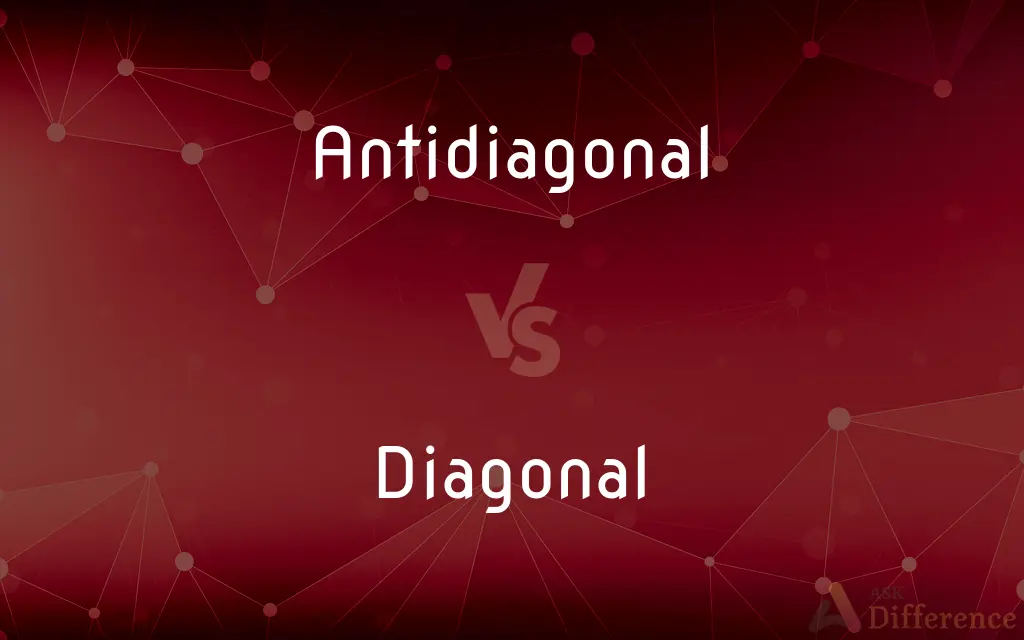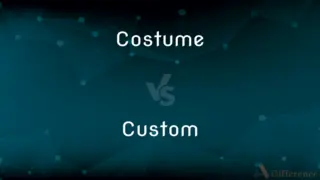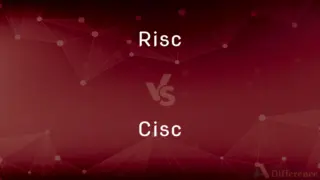Antidiagonal vs. Diagonal — What's the Difference?
Edited by Tayyaba Rehman — By Urooj Arif — Updated on March 15, 2024
Diagonals connect corners of shapes; antidiagonals also connect, but cross opposite to diagonals' path.

Difference Between Antidiagonal and Diagonal
Table of Contents
ADVERTISEMENT
Key Differences
Diagonals are lines or segments that connect opposite corners of polygons or matrices, offering a straight path across the structure. In contrast, antidiagonals connect corners as well, but in a matrix, they run perpendicular to the primary diagonal, typically from the top right to the bottom left.
While diagonals are central to discussions about polygons and matrices, emphasizing symmetry and geometry, antidiagonals often emerge in matrix discussions, underscoring a different perspective of symmetry, especially in square matrices.
While diagonals in a polygon divide it into non-overlapping triangles, helping in calculations like area, antidiagonals don't have a direct geometric counterpart in polygons but are crucial in matrix operations, highlighting an alternate way to traverse or analyze the data.
In the context of a square matrix, the primary diagonal is typically from the top left to the bottom right, focusing on the elements where the row and column indices are equal. On the other hand, the antidiagonal focuses on elements where the row and column indices sum up to one less than the size of the matrix, offering a complementary view. Diagonals often play a role in algorithms and formulas related to mathematics and computer science, such as calculating determinants or features of a matrix.
Antidiagonals are key in specific operations like flipping a matrix or in certain algorithms that require reverse traversal or symmetry operations. The significance of diagonals extends beyond mathematics into art and architecture, symbolizing balance and stability, while antidiagonals, though less commonly referenced outside of mathematics, suggest an alternate or reverse perspective, challenging conventional symmetry.
ADVERTISEMENT
Comparison Chart
Definition
A line segment connecting two opposite corners of a polygon or a matrix.
A line segment connecting two corners of a matrix in the opposite direction of the main diagonal, usually from top right to bottom left.
Presence in Shapes
Present in polygons and matrices.
Primarily present in square matrices.
Direction in Matrix
For a square matrix, runs from the top left to the bottom right corner.
Runs from the top right to the bottom left corner.
Mathematical Role
Used to calculate determinants, trace, and in symmetry operations.
Used in specific matrix operations and reverse traversal algorithms.
Symbolism
In art and architecture, symbolizes balance and stability.
Represents an alternate perspective or challenge to conventional symmetry.
Compare with Definitions
Antidiagonal
A feature in art and design.
Diagonals add dynamism to compositions.
Diagonal
A specific line segment in square matrices.
The antidiagonal of a matrix runs from the top right to the bottom left.
Antidiagonal
A tool in geometry and algebra.
Calculating the diagonal helps in understanding the shape's properties.
Diagonal
A symbolic representation of alternate views.
The antidiagonal in art suggests looking at things differently.
Antidiagonal
A line segment inside a polygon or matrix.
The diagonal of a square connects two opposite corners.
Diagonal
Represents reverse or complementary perspective in data.
Traversing the antidiagonal offers a different data view.
Antidiagonal
A mathematical operation.
The matrix diagonal elements are key in determinant calculation.
Diagonal
Used in matrix operations and algorithms.
Antidiagonal elements are flipped in certain transformations.
Antidiagonal
A path or shortcut in navigation.
Moving diagonally across a grid saves time.
Diagonal
A concept in advanced mathematics.
Antidiagonals assist in unique problem-solving scenarios.
Antidiagonal
(linear algebra) The diagonal of a matrix that leads from top-right towards bottom-left.
Diagonal
In geometry, a diagonal is a line segment joining two vertices of a polygon or polyhedron, when those vertices are not on the same edge. Informally, any sloping line is called diagonal.
Diagonal
Joining two nonadjacent vertices of a polygon.
Diagonal
Joining two vertices of a polyhedron not in the same face.
Diagonal
Having a slanted or oblique direction.
Diagonal
Having oblique lines or markings.
Diagonal
Relating to or being the front left and back right feet or the front right and back left feet of a quadruped.
Diagonal
(Mathematics)A diagonal line or plane.
Diagonal
Something, such as a row, course, or part, that is arranged obliquely.
Diagonal
A fabric woven with diagonal lines.
Diagonal
A virgule.
Diagonal
(geometry) Joining two nonadjacent vertices (of a polygon or polyhedron).
Diagonal
Having slanted or oblique lines or markings.
Diagonal
Having a slanted or oblique direction.
Diagonal
Of or related to the cater-corner (diagonally opposite) legs of a quadruped, whether the front left and back right or front right and back left.
Diagonal
(geometry) A line joining non-adjacent vertices of a polygon.
Diagonal
Anything forming or resembling such a line, particularly:
Diagonal
(geometry) A line or plane at an oblique angle to another.
Diagonal
A line or cut across a fabric at an oblique angle to its sides.
Diagonal
Synonym of slash⟨/⟩.
Diagonal
Joining two not adjacent angles of a quadrilateral or multilateral figure; running across from corner to corner; crossing at an angle with one of the sides.
Diagonal
A right line drawn from one angle to another not adjacent, of a figure of four or more sides, and dividing it into two parts.
Diagonal
A member, in a framed structure, running obliquely across a panel.
Diagonal
A diagonal cloth; a kind of cloth having diagonal stripes, ridges, or welts made in the weaving.
Diagonal
(geometry) a straight line connecting any two vertices of a polygon that are not adjacent
Diagonal
A line or cut across a fabric that is not at right angles to a side of the fabric
Diagonal
An oblique line of squares of the same color on a checkerboard;
The bishop moves on the diagonals
Diagonal
(mathematics) a set of entries in a square matrix running diagonally either from the upper left to lower right entry or running from the upper right to lower left entry
Diagonal
A punctuation mark (/) used to separate related items of information
Diagonal
At an angle; especially connecting two nonadjacent corners of a plane figure or any two corners of a solid that are not in the same face;
A diagonal line across the page
Diagonal
Having an oblique or slanted direction
Common Curiosities
Why are diagonals important in mathematics?
Diagonals are important for calculating determinants, understanding geometric shapes, and dividing polygons into triangles.
How do diagonals and antidiagonals differ in their paths?
Diagonals typically run from the top left to the bottom right in a matrix, whereas antidiagonals run from the top right to the bottom left.
How are antidiagonals used in matrix operations?
Antidiagonals are used in specific algorithms, including matrix flipping and reverse traversal operations.
How do diagonals and antidiagonals contribute to symmetry?
Diagonals contribute to conventional symmetry, while antidiagonals provide an alternate or reverse perspective on symmetry.
What is an antidiagonal?
An antidiagonal in a matrix is a line that connects two corners, running in the opposite direction of the main diagonal, usually from the top right to the bottom left.
Can every polygon have antidiagonals?
No, the concept of antidiagonals mainly applies to square matrices and not to polygons.
How does the concept of antidiagonals challenge conventional views?
Antidiagonals suggest looking at problems and structures from a different, often reverse, perspective, challenging traditional symmetry.
Do diagonals have a role outside of mathematics?
Yes, diagonals are significant in art, architecture, and design, symbolizing balance and adding dynamism to compositions.
What makes antidiagonals unique in square matrices?
Antidiagonals offer a complementary perspective by connecting elements from the top right to the bottom left, unlike the primary diagonal.
Can the concept of antidiagonals be applied to non-square matrices?
Generally, antidiagonals are specific to square matrices because of their geometric properties.
Are diagonals used in navigation?
Yes, moving diagonally can offer shortcuts and efficient paths in navigation and grid-based layouts.
Can diagonals divide polygons into specific shapes?
Yes, diagonals can divide polygons into triangles, which helps in calculating areas and understanding geometric properties.
What is a diagonal?
A diagonal is a straight line connecting two opposite corners of a polygon or the elements of a matrix that stretch from one corner to another, typically from top left to bottom right.
How do antidiagonals affect matrix transformations?
They play a crucial role in specific transformations, like flipping, by reversing the order of elements along the antidiagonal.
Are diagonals and antidiagonals equally important in mathematics?
Both have their unique applications and importance, with diagonals being more universally applicable in various mathematical and geometric contexts, while antidiagonals have specific uses in matrix operations and algorithms.
Share Your Discovery

Previous Comparison
Costume vs. Custom
Next Comparison
RISC vs. CISCAuthor Spotlight
Written by
Urooj ArifUrooj is a skilled content writer at Ask Difference, known for her exceptional ability to simplify complex topics into engaging and informative content. With a passion for research and a flair for clear, concise writing, she consistently delivers articles that resonate with our diverse audience.
Edited by
Tayyaba RehmanTayyaba Rehman is a distinguished writer, currently serving as a primary contributor to askdifference.com. As a researcher in semantics and etymology, Tayyaba's passion for the complexity of languages and their distinctions has found a perfect home on the platform. Tayyaba delves into the intricacies of language, distinguishing between commonly confused words and phrases, thereby providing clarity for readers worldwide.















































